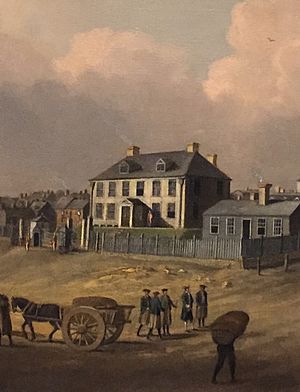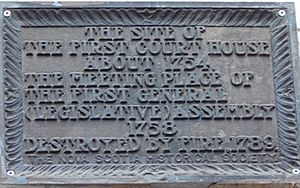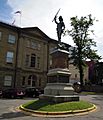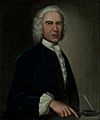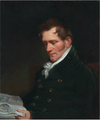Province House (Nova Scotia) facts for kids
Quick facts for kids Province House |
|
|---|---|
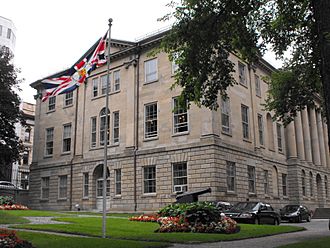 |
|
| General information | |
| Architectural style | Palladian |
| Town or city | Halifax, Nova Scotia |
| Country | Canada |
| Construction started | 1811 |
| Opened | 1819 |
| Design and construction | |
| Architect | John Merrick |
| Official name: Province House National Historic Site of Canada | |
| Designated: | 1993 |
| Type: | Provincially Registered Property |
| Designated: | 1983 |
Province House in Halifax is a very important building. It is where the Nova Scotia government meets. This building has been used by the Nova Scotia House of Assembly every year since 1819. This makes it the longest-serving government building in Canada. It is also Canada's oldest house of government. Province House is three storeys tall. It is a great example of Palladian architecture in North America.
Contents
History of Province House
Province House was built on the same spot as an older building called the Governor's House. That house was built in 1749. Province House first opened its doors on February 11, 1819. It is one of the smaller government buildings in North America. At first, it held all parts of the colony's government. This included the law-making, executive, and court functions.
The Supreme Court of Nova Scotia used to meet in Province House. This room is now the legislative library. A famous event happened here on March 2, 1835. A journalist named Joseph Howe was put on trial. He had written a letter saying that some politicians and police were misusing money. The judge wanted Howe to be found guilty. But Howe gave a powerful speech to defend himself. The jury decided he was innocent. This case was very important for freedom of the press in Canada. It meant newspapers could report more freely.
On January 20, 1842, the famous English writer Charles Dickens visited. He watched the Nova Scotia Legislature open. He said it was like looking at Westminster through the wrong end of a telescope.
In 1848, Province House became the site of the first "responsible government" outside the United Kingdom. This meant that the government had to answer to the people's elected representatives. The building is in downtown Halifax. It is on a block surrounded by Hollis, Granville, George, and Prince streets.
After Nova Scotia joined Canada in 1867, Joseph Howe led a group that won many votes. This group was against Nova Scotia joining Canada at first.
Province House was named a National Historic Site of Canada in 1996. This was because it is Canada's longest-serving government building. It also played a key role in developing responsible government and press freedom in Canada. It is also a provincially protected heritage site.
Nova Scotia's Legislative Assembly
Province House is the home of the Nova Scotia House of Assembly. This is Nova Scotia's elected group of lawmakers. In 1908 and 2008, big celebrations took place. They marked 150 and 250 years of parliamentary democracy in Canada. This type of government started in Nova Scotia. The 250-year celebration was called Democracy 250.
The Nova Scotia House of Assembly first met on October 2, 1758. It was in a simple wooden building in Halifax. Twenty-two men met to make decisions for the colony. Only Protestant men who owned land could vote then. It was a small start, and they had limited power. But it was the first elected assembly in what would become Canada.
On January 31, 1837, Simon d'Entremont and Frederick A. Robicheau became the first Acadians elected. Later, on March 24, 1837, black men in Canada gained the right to vote. In 1893, Edith Archibald tried to pass a law. It would let women who owned property vote in Nova Scotia. The law passed in the legislature. But the Attorney General stopped it.
On April 26, 1918, women in Nova Scotia gained the right to vote. This was thanks to the Local Council of Women of Halifax. Nova Scotia was the first Atlantic province to do this. A month later, Canada's Prime Minister, Robert Borden, helped women across Canada get the right to vote. On February 1, 1961, Gladys Porter was the first woman elected to the Assembly. In 1993, Wayne Adams became the first Black member elected. Nova Scotia was the third province in Canada to pass human rights laws (in 1963).
-
The House of Assembly Chamber. Paintings of Joseph Howe (left) and James William Johnston (right) are shown.
-
A painting of Joseph Howe by Henry Sandham.
The Library (Former Supreme Court)

The Legislative Library is on the second floor. It is between the Red Chamber and the Legislative Assembly. This room was once the home of the Supreme Court of Nova Scotia. The court moved when it needed more space. The first important trial here was in 1819. It was about the last deadly duel in Nova Scotia.
The Supreme Court room was also where Joseph Howe had his famous trial in 1835. He defended himself against charges of writing things that upset politicians. Many people believe Howe's success in this case was a big step. It helped make sure newspapers in Canada could report freely.
The Red Chamber
The Red Chamber used to be where the Nova Scotia Council met. Later, it was for the Legislative Council. This was like an "upper house" of the government. Its members were chosen by the governor. This council was ended in 1928. Now, the Red Chamber is used for meetings and special events.
-
This table was used by Edward Cornwallis for his first Nova Scotia Council meeting in 1749. It is in the Red Chamber.
-
Sir William Williams, 1st Baronet, of Kars with a sword from the Nova Scotia House of Assembly.
-
Grand Chief Jacques-Pierre Peminuit Paul (third from left) meets the Governor General of Canada in the Red Chamber in 1879.
Court Yard and Statues
Province House has two important statues outside. To the north is the South African War Memorial. It honors those who fought in the Second Boer War. It was made by Hamilton MacCarthy. One part shows the Battle of Witpoort, where Nova Scotian Harold Lothrop Borden died.
To the south of Province House is a statue of Joseph Howe. This statue was made by the famous Quebec artist Louis-Philippe Hébert.
On the north side of Province House, there is a cannon from the British ship HMS Shannon. On the south side, there is a cannon from the American ship USS Chesapeake. This American ship was captured by the British in the War of 1812.
-
The statue of Joseph Howe by Louis-Philippe Hébert.
-
A cannon from the American ship USS Chesapeake.
-
A cannon from the British ship HMS Shannon.
Images for kids
There are also portraits of former prime ministers John Sparrow David Thompson and Robert Borden inside Province House.
See also
 In Spanish: Province House (Nueva Escocia) para niños
In Spanish: Province House (Nueva Escocia) para niños


